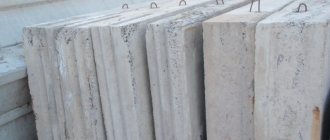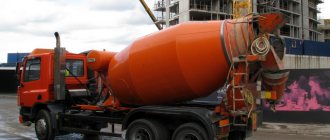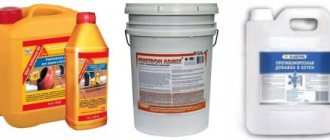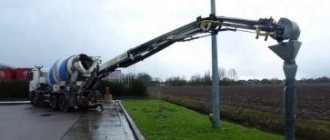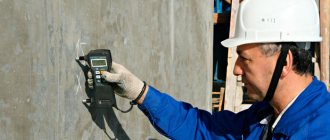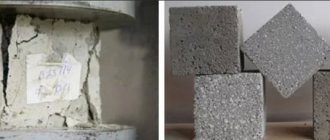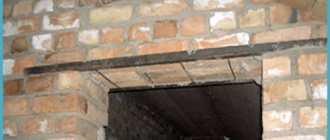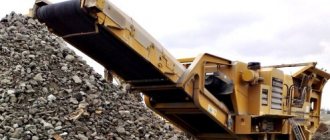Types of equipment for concrete
All construction sites cannot do without concrete mortar. Even wooden buildings require the use of artificial stone when creating a foundation to ensure the reliability and durability of the entire structure.
In addition to transporting the required amount of concrete mixture, it is necessary to unload and supply it to the place of use. A concrete bucket is used for these purposes. The article introduces the types of structures, their features and manufacturing methods.
Features of using the equipment
Using a bucket to deliver concrete to a construction site
Before getting acquainted with the types of containers for supplying concrete, it is worth determining what they are needed for and the advantages of the equipment.
Concrete buckets are used:
- When unloading the solution from any type of transport, including a concrete mixer truck;
- When pouring the mixture into hard-to-reach places in the structure;
- To ensure the supply of trains when transport access to the unloading site is difficult;
- For work in small areas and the absence of a powerful crane, a concrete bucket is the best option.
The solution must be supplied to the container under certain conditions.
These include:
- Ability to carry out work at a relatively low speed;
- The need for equipment to lift the tub;
- Possibility of delivering the train to the loading site;
- Several workers must unload this bunker.
When doing monolithic construction with your own hands, such a container is not always needed - modern stationary concrete pumps easily supply the solution over hundreds of meters.
Even systems with smaller capacities mounted on a truck chassis can perfectly cope with delivering the composition to formworks located at a height of up to 30 meters. But the cost of such a process is quite high.
Concrete tub: types and manufacturing methods
All construction sites cannot do without concrete mortar. Even wooden buildings require the use of artificial stone when creating a foundation to ensure the reliability and durability of the entire structure.
In addition to transporting the required amount of concrete mixture, it is necessary to unload and supply it to the place of use. A concrete bucket is used for these purposes. The article introduces the types of structures, their features and manufacturing methods.
Design and principle of operation of the tub
Tub with a capacity of 1 m³
The design includes:
- Pos. 1 – tank in the form of a cone;
- Pos. 2 – gate;
- Pos. 3 – control handle;
- Pos. 4 and 5 – elements for fixing the gutter;
- Pos. 6 – trench for supplying solution;
- Pos. 7 – funnel;
- Pos. 8 – loop for transportation;
- Pos. 9 – visor.
Most often, the container is made in the shape of a truncated cone, which is connected to a cylindrical shell. The gate serves to regulate the supply of the mixture using a handle with a lever mechanism.
When transporting equipment, the chute is fixed with a lock, pos. 4, and when pouring the mixture through the chute with a retainer, pos. 5. Through the chute pos. 6 ensures the direction of the solution flow. Funnel pos. 7 with a flange prevents splashing of the composition when mixing and when unloading the mixture.
Rubberized sleeve for unloading concrete
Tip: To unload the construction mixture into a hard-to-reach place, put a rubberized sleeve on the flange.
Tub "shoe"
The container shown in the photo is distinguished by the design of the housing, which conventionally consists of three parts:
- Rectangular receiver for concrete or mortar mixture;
- A bunker shaped like a truncated pyramid;
- A two-section valve, with the help of which the angle and intensity of the supply of concrete solution is adjusted.
The concrete receptacle and shoe hopper are usually made of rolled metal. To strengthen the body of the device, a longitudinal frame is additionally constructed from channels, which prevents deformation of the tub when it is fully loaded.
Hinges for transporting or unloading containers using lifting equipment are attached to channels reinforcing the structure. Special elements are additionally attached to the reinforcing frame, which ensure that the container is tilted at the required angle when unloading the solution or concreting the area.
The shoe has a special shutter, both doors of which have their own handles for control. This design allows for adjustment of the mixture supply. Special safety rings on the handles protect the tub from accidental opening of the shutter.
Tip: Due to the design, the mixture may not be completely discharged without additional impact. Therefore, a shoe-shaped product should be equipped with a mounted vibrator.
When transporting equipment, the lifting mechanism is attached to the tub using transport loops. To transport dry mixtures and hard concrete, a mechanical vibrating bucket is used. The container in this case is supplied with an electric motor mounted on a conical tank.
In addition, the container may have a technological platform intended for the operator and delivery of technological equipment to the concreting area for lifting the bunker with concrete. The cone hopper can only be used in a vertical position. And its volume can be v=0.75; v=0.8 cubic meters
Features of the bucket for supplying concrete “Ryumka”
Another option for a bunker is a “shot glass” concrete bucket. It is also called: vertical round (VRK) or non-rotating tub - BN. The container is filled with concrete mixture and transported in a vertical position. It has a tray for directional supply of concrete. The jaw-type valve easily opens the outlet and closes it tightly using a lever. BN is used at sites where there are construction cranes.
The described design options are available in various types depending on the volume of the tub. It varies from 0.5 to 2.5 cubic meters. With an increase in the volume of the bunker, the load capacity increases from 2500 kg to 6000 kg and the dead weight of the product increases from 300 to 1600 kg. An important characteristic of a concrete bucket is the price of the product. It ranges from 20 to 35 thousand rubles, depending on the load-carrying capacity of the structures and the pricing policy of the companies producing these products.
Don’t forget about the possibility of purchasing equipment for rent. Rent of concrete buckets is usually offered by the companies that produce them. Sometimes this makes more sense than buying a bunker. If a device for a concrete mixture is needed for one-time use, then it will be more profitable to pay for its rental than to spend money on buying a tub as personal property.
In any case, a concrete bucket is a necessary element of construction equipment and equipment for the working sector of buildings. This product ensures the transportation of concrete mixtures to any place under construction, extends the time interval for their use, reduces losses of materials due to dosage, maintaining the mixture in working condition and complete unloading using electric vibrators. The choice of the desired bunker model depends on the scale of construction and the equipment of the construction site.
Types of devices
Types of equipment for concrete
Such equipment is used to supply concrete mortar to the formwork or to the place where it is laid in small portions.
Concrete bunkers are available in two types:
| Tub type | Peculiarities |
| A glass, bell or bell is a non-rotating container for concrete, shaped like a truncated cone with a cylindrical part at the top.
Universal products can be equipped with a sleeve. |
| This device has the shape of a rectangle, tapering towards the bottom.
|
Both options are used if unloading equipment is available. Such buckets for concrete mortar are produced in small volumes: from 0.5 m³ to 3 m³. This allows you to move structures with any mobile crane or manipulator.
Sizes of structures for different volumes
Types of buckets for concrete
At this point in time, there are three types of buckets for supplying large volumes of concrete to places where it is directly used: “Shoe”, “Wine Glass” and “Mortar Box”. Let's take a closer look at the features of each device.
Rotary device for supplying concrete “Shoe”
The “Shoe” tub is a steel container with variable geometry, containing from 1 to 4 m3 of solution. The body of the container looks like a truncated pyramid, reminiscent of a woman's shoe. On one side of the container there is a rectangular hatch for loading concrete, and in the area of the top of the pyramid there is a hatch for unloading the solution, closed with a special sector shutter.
Main structural elements:
- The body is a welded structure made of sheet steel reinforced with steel channels. To allow movement, the “Shoe” body is equipped with two hinged welded eyes. On the top surface there is a platform for installing a vibrator. The vibrator is used for temporary storage of concrete and for cleaning the container from material residues;
- The shutter consists of two sections hinged. Each section has its own handle, fixed in the non-working position with a special ring. In some Shoe models, the shutter is opened and closed by a steering wheel;
- Section drive;
- Frame.
The “Shoe” is loaded in a horizontal position, and moved and unloaded in a horizontal position by appropriate lifting equipment, usually a tower crane.
Buckets for supplying concrete of the “Glass” design
The “Wine Glass” or “Bell” is a non-rotating, vertically standing structure. This is a bucket for universal-purpose concrete with a capacity of 0.5 to 3 m3 of material.
Main structural elements:
- Frame. It is a welded steel bunker for concrete consisting of a cylindrical and truncated conical part, only a truncated conical part, or a cylindrical and truncated pyramidal part. In this case, the cylindrical part is the loading hatch, and the truncated part of the cone or pyramid is the unloading hatch. In the upper part of the body there is a welded reinforcing ring belt made of a channel or two channels. There are 4 eyes welded along the perimeter of the belt for fastening the slings of the load-lifting device;
- Stand (support). It has a ring shape with 4 posts for welding the body. Made from channels;
- Tray attachment. Serves for supplying concrete to places of use or distribution into intermediate containers.
The main difference between the “Glass” and the “Shoe” is the same loading, transport and working position (vertical).
"Mortar box"
There are three types of configurations for this product: “Scoop Box”, “Boat Box” and “Trough Box”.
- The “scoop box,” depending on the dimensions and thickness of the steel sheet (2, 2.5 or 3 mm), has a capacity of 0.5 to 3 m3 of material. It is a welded rectangular structure, open at the top, reminiscent of a children's scoop. The side walls of the scoop are reinforced with corners, and the top has a reinforcing flange. Along the perimeter of the flange there are 4 welded eyes for movement. At the bottom of the rear wall there are 2 welded eyes for tilting the container;
- The “boat box”, depending on the dimensions and thickness of the steel sheet, has a capacity of 0.25 to 0.5 m3 of material. Structurally, it is a welded trough made of steel sheet made in the form of a truncated pyramid. Following the example of the top of the trough, there is a flange and 4 welded eyes for slinging and moving;
- A “trough box” generally has a capacity of 0.25-0.27 m3 of material. It has the shape of a welded trough with four or two upper welded eyes for movement.
Preparing to make a tub
Container for self-production
If you want to make your own container for supplying concrete, you should give preference to a device in the shape of a glass. The price of such a product is less than a similar one, but shaped like a shoe.
In this case, you need to purchase:
- Rolled products of the required thickness and quality;
- For installation of the structure - special guides;
- Welding apparatus;
- Cutting tools of any type.
Tip: For self-production and home use, the container volume should be chosen small, approximately 0.5 m³. In this case, there is no need to manufacture an additional cylindrical upper part of the body, which will increase the loading speed of the device.
A truncated cone is a regular prism, the bases of which have diameters of different sizes.
Instructions for obtaining the workpiece:
- Based on the required volume, calculate the parameters of the cone:
Dimensions of a truncated cone
Formula for calculating body dimensions
Having determined the optimal dimensions of the radii of the product, its height is calculated.
- Based on the obtained dimensions, a part template is prepared;
- The template is transferred to a metal sheet.
Making a container
Product drawing
When making a tub yourself, you should remember that the material for the container is constantly exposed to the aggressive effects of the building mixture and moisture. Therefore, it is advisable to choose rolled steel from stainless steel or take into account the thickness of the metal. In this case, the steel grade must be low-carbon, easily weldable.
After transferring the template for the cone blank onto the rolled metal, the part is cut out using a grinder, rolled and welded.
Preparing the cone part
Construction tub for concrete mixtures 'Shoe'.
A device for moving bulk cargo is a skimmer. We have come into use with the old word tub, which is really more suitable for the designation of the structure being described.
Portable bunker-tub for mortar concrete mixture.
Construction organizations use more than one type of tub, which differ in design and internal volume.
A description with fragments of personal drawings of the 'Shoe' concrete mix tub is offered in the following description.
The production of the tub (cubel) was based on the documents of GOST 21807-76 in compliance with the specified parameters and recommendations.
The 'Shoe' type bucket for concrete mix is by far the most convenient to use. Its loading opening is made to size for loading directly from a concrete mixer or concrete mixer. The concrete solution is loaded when the tub is in a horizontal position. The shutter is in the closed state at this time. After loading, the tub of mortar is transported by a crane or hoist to the technological process site, where workers use the concrete mortar mixture in doses or all at once.
Description of the design of the portable bunker 'Shoe' for concrete mixture.
The 'Shoe' tub is made in volumes from 0.5m3 to 8m3. You can independently make a tub for any required volume.
Here is an example of our concrete mortar bucket.
The body of the hopper is made of hot-rolled sheet metal 6mm thick from steel grade VSt3ps in accordance with GOST 380. When manufacturing a larger-volume bucket, the wall thickness must be increased. The entire perimeter of the body is reinforced with a metal corner 45x45x5 (VStp3s GOST - 380), which acts as stiffening ribs, and in the lower part of the tub structure, the frame from the corner acts as a mounting platform for the shutter valve. On one of the walls of the tub body there is a platform for a low-voltage electric vibrator.
The shutter valve of the bucket is rotary, segment-type, easily doses the flow of concrete mixture and reliably keeps the concrete solution in the bucket hopper from spontaneous emptying. When the valve moves, it does not jam due to single components of the concrete filler (crushed stone, gravel, slag, expanded clay) getting into the mechanism, since the valve, during closing, slides along the guides of the valve neck and pushes out excess solution and everything that gets into the gap between the valve valve and edge of the bolt neck.
The shutter lever lock is not indicated on the drawings. It can be of any type.
The longer the lever, the lighter, but the less convenient. A short lever is more convenient, but it is difficult to control the bolt mechanism. The control must be made in such a way that the force directed to the lever when closing the bucket shutter does not exceed 6 kgf (60N).
All structural parts of the tub, except for the bunker, are made removable and can be replaced or repaired at any necessary time. Of course, your 'Shoe' tub can be assembled using a welded joint, but I will immediately warn you that equipment sometimes breaks at a construction site. A tub will fall from a certain height. Deformed. What if she comes with a solution? This is where collapsible connections will come in handy. Replace or repair only the damaged part. All costs will be lower.
Like other construction equipment, the tub must be cleaned of mortar after use and the valve and its mechanism must be washed. Inspect externally for cracks, tears and the condition of the lifting hinges.
Let me remind you that the drawings are amateur and made for a personal archive, but at the request addressed to me more than once, I am sharing its fragments with everyone.
Types of containers for supplying concrete, their design and features
The scale of modern construction, both in terms of volume and height of objects, using reinforced concrete structures erected on site, requires the delivery of concrete in huge quantities to the pouring sites. It is this task that is performed by buckets (concrete mass bunkers - BBM) for concrete. With their help, the concrete mixture is delivered from the loading point to the places where formwork is poured, concrete floors or monolithic frame columns are formed. The bucket for supplying concrete can be placed in any place convenient for construction work. In addition, this device is used for short-term storage of concrete.
When producing concrete buckets, the following functional characteristics must be provided: - strength and anti-corrosion properties of the materials from which they are made; — reliability of the design; — ergonomics of the device, ensuring ease of loading, unloading and transportation; — sufficient volume; — additional devices in the form of electric vibrators that ensure complete unloading of material from the hopper and prevent subsidence of concrete.
The bunkers are made of high-strength steel, 2 mm thick, which has anti-corrosion properties. This material gives the product the necessary strength, allows it to be used in various weather conditions, and makes it resistant to mechanical damage. The latter are inevitable in construction conditions. Ultimately, the strength of steel guarantees the safety and long-term use of containers. The reliability of the bunkers is ensured by strengthening the upper part of the structure with channels and the presence of strong fastening loops.
Review of the most popular options and their advantages and disadvantages
As noted above, there are mainly two types of structures used, and you need to decide which one is suitable for a particular construction project. They differ in many characteristics, and it is important to choose the best option.
Shot glass design
A bucket glass for concrete is one of the simplest types of products, which provides invaluable assistance in the process of work. But you need to understand that products of this type may differ from each other, and choosing a specific option can be difficult, even if you do not buy, but rent the device. After all, productivity and ease of use depend on the right decision.
It was the appearance that determined the name of the glass (some call this type a bell)
Let's consider what criteria you should pay special attention to, whether purchasing new equipment or used units:
- The material used to make the product, most often steel, must be very durable . Insufficient thickness does not provide the required reliability. If you choose a used tub, then pay attention to the absence of damage; sometimes eliminating them will cost more than the product itself.
- Also check other elements - each unit must be strong and reliable.
- If you need a device with a capacity of 1 m3, you should not purchase an option twice as large : it is much heavier, and it will be inconvenient to work with.
A bucket for supplying concrete of this type consists of several main parts:
- The main container, made either simply in the shape of a cone, or as a cone with a cylinder on top. The features of this system depend on the required capacity.
- The support system is also of great importance; it can be of a wide variety of configurations. The main requirement for it is the strength and stability of both empty and full containers.
- A very important part of the design is the shutter with a handle with which the solution is unloaded; the shutter must be durable and the opening handle comfortable. (See also the article Cladding aerated concrete: how to do it.)
A comfortable valve handle is an important part of the design
- Eyelets for attaching the structure to the crane and lifting it are very important, since the safety of everyone on the construction site directly depends on it.
Important! Remember that this type of structure is non-rotating, that is, unloading is always done in the same direction. This is convenient when pouring static structures of the same type, but sometimes more precise distribution of the solution is required.
Shoe type design
This is a more progressive option, but its price is noticeably higher; the requirements for strength and quality of materials for such structures are similar to those discussed above. (See also the article Concrete crushed stone: features.)
Instructions for checking the product yourself are as follows:
- First, all structural elements are carefully inspected for reliability and absence of damage.
- If the unit is used, then look inside the bunker: if it has not been cleaned, then a layer of hardened concrete can create a lot of problems for you.
Due to its external features, this type of design is called a shoe or galosh
This option has a number of advantages:
- The design of the product is rotary, which allows you to adjust the direction of unloading concrete and increases the ease of use of the bucket. It is this advantage that determines the popularity of this type of product.
- The structure may have a platform for installing a vibrator, which significantly speeds up the unloading process and prevents concrete from sticking to the walls.
- Another undoubted advantage is the ability to load the solution both from a mixer and from a dump truck; this can simplify the work and reduce the cost, since special transport is much more expensive than conventional trucks.
- Despite the large capacity and reliability of the products, their unloaded weight is relatively small, which increases ease of transportation.
- Loading such containers is much easier, since this is done with the tub in a horizontal position (transportation is carried out in a vertical position).
Convenience of loading the container is another important advantage
